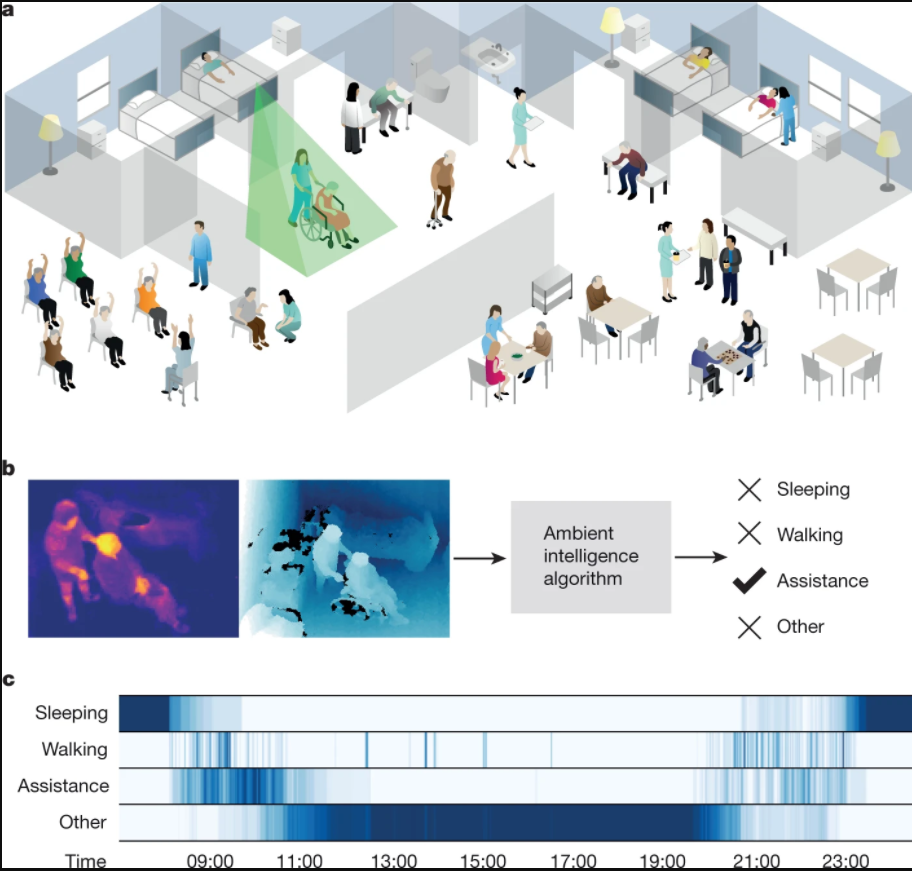
Ambient intelligence simply described is the use of machine learning to data collected from contactless sensors that are sensitive and responsive to presence of humans in physical spaces. These sensors provide motion detection, depth detection, audio recording, video images, ambient temperature, air quality and gas detection. This is an emerging branch of Artificial Intelligence that has a potential to improve healthcare.
Ambient intelligence can improve the understanding of unobserved spaces of healthcare such as hospital spaces, elderly homes and even private residences. Advances in ambient intelligence can help prolong the independence of older individuals living alone and improve the management of chronic diseases by analysing daily behaviour.
In a path breaking article in the Nature magazine, AI scientists (see citation below) reviewed the role of ambient intelligence in bringing breakthrough progress in healthcare. I reproduce a gist of his research and findings that I found interesting and informative and which in some measures is aligned to our research work in AI in the healthcare sector. emQube team has been researching ways to bring emotional relief and discipline to patients undergoing treatment in hospitals, or convalescing at home.
Original Article: Haque, A., Milstein, A. & Fei-Fei, L. Illuminating the dark spaces of healthcare with ambient intelligence | Nature

Fig. 1: Contactless sensors for ambient intelligence. | Nature
The article discusses the advent of ambient intelligence in various areas such as :
ICU — computer-assisted monitoring of patient mobilization
Hospitals — frequent washing of hands to reduce infection
Operating Rooms — feedback on surgery skills for coaching and keeping count of surgical tools
Clinics — automatic transcription of medical diagnosis and prescription
Home — monitoring mental illness, fall detection, care-giver activity
Let’s learn a little more about each of these use cases.
Intensive Care Units
It is estimated that over 400,000 people die in the US owing to lapses and defects in clinical decision-making and physical action which can be reduced with the help of ambient intelligence. To avoid overburdening the cognitive capabilities of clinicians, advances in artificial intelligence hold the promise of assisting clinicians, not only with clinical decisions but also with the physical steps of clinical decisions.
Intensive care units (ICUs) are specialized hospital departments in which patients with life-threatening illnesses or critical organ failures are treated and currently account for up to 13% of all hospital costs.
One promising use case is the computer-assisted monitoring of patient mobilization to combat ICU-acquired weaknesses which are a common neuromuscular impairment in critically ill patients, and can cause a twofold increase in one-year mortality. The standard mobility assessment through direct, in-person observation can be assisted with contactless ambient sensors that provide the continuous and nuanced understanding needed to accurately measure patient mobility in ICUs.
Reduce Hospital Infections
Another early application is the control of hospital infections wtih monitoring proper compliance with hand hygiene protocols. Ambient sensors could monitor handwashing activities with higher fidelity as opposed to the current practice of detecting motion which could even be triggered from a clinician walking near a dispenser.
Operating Rooms
Worldwide, more than 230 million surgical procedures are undertaken annually with up to 14% of patients experiencing an adverse event. This percentage could be reduced through quicker surgical feedback, such as more frequent coaching of technical skill, which could reduce the number of errors by 50%. Ambient intelligence using video footage are an unobtrusive method to reconstruct trajectories of instruments during surgery could potentially lead to improved surgical training.
Another example is the surgical count — a process of counting used objects to prevent objects being accidentally retained inside the patient. Ambient intelligence promises to overcome attention deficit and insufficient team communication with ceiling mounted cameras to track bodily parts of surgical teams to ensure that all objects used in the surgery are accounted for.
Medical Transcription
Another area being currently researched is the automatic transcription of physicians diagnoses using audio recording. This could reduce the dependence on medical scribes and instead allow outpatient audio of conversation between patient and physician to transcribe to an accuracy of 80% which is higher than 76% of medical scribes (based on one particular study of 90,000 conversations)
Elderly Care
The elderly spend a considerable portion of time at home and it will also increase the importance of independent living, chronic disease management, physical rehabilitation and mental health.
The use of ambient intelligence can help understand the activity of care-givers to ensure that adequate assistance is provided. Privacy concerns are a matter of debate but the overarching benefits could tide over this obstacle to use ambient monitors to improve elderly care. Also the use of acoustics and radar sensors, rather than cameras, may prove a good alternative.
Fall Detection at home
Another critical use of AI is to detect falls and alert emergency services. Approximately 29% of community-dwelling adults fall at least once a year.
Laying on the floor for more than one hour after a fall is correlated with a fivefold increase in 12-month mortality. Furthermore, the fear of falling — associated with depression and lower quality of life — can be reduced due to the perceived safety benefit of fall-detection systems.
A systematic review found that wearable devices detected falls with 96% accuracy while ambient sensors were 97% accurate.
Summary
The nascent nature of ambient intelligence does have its own set of technical challenges that needs to be overcome, but it has very promising benefits. Breakthroughs in artificial intelligence and low-cost, contactless sensors have given rise to an ambient intelligence that can potentially improve the physical execution of healthcare delivery.
Latest Posts
Categories
- Business
- E-Commerce
- Emerging Technologies
- Facility Management
- Influencers
- Intellectual
- Marketing
- Mobile Development
- Personal
- Sales Management
- Search Engine Marketing
- Social Media
- Software
- Spiritual
- Web Layout



